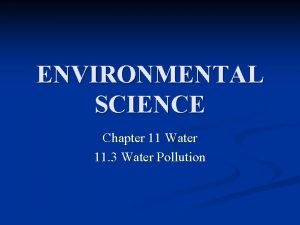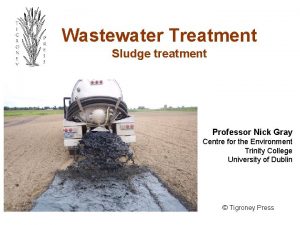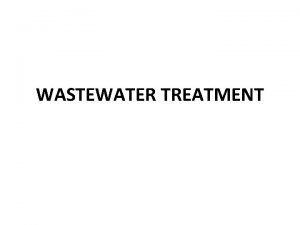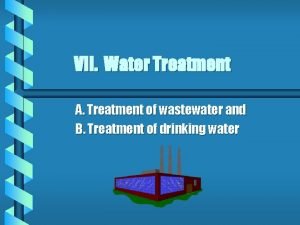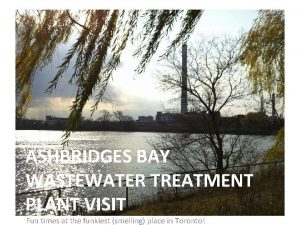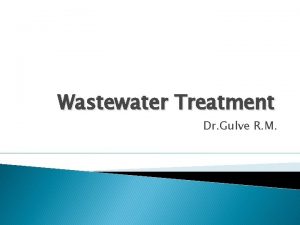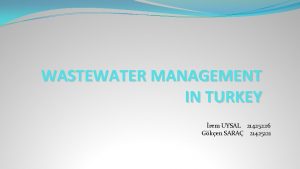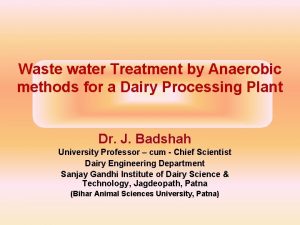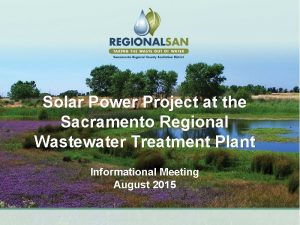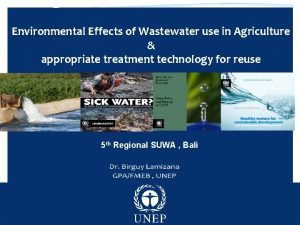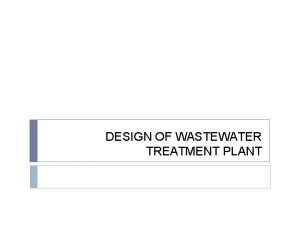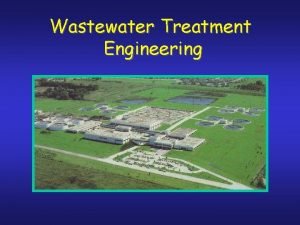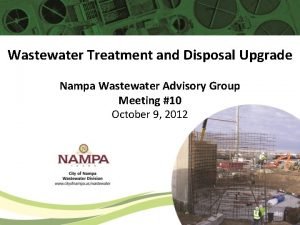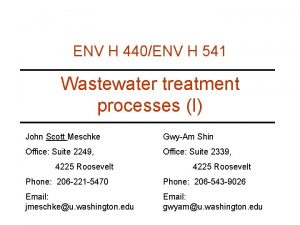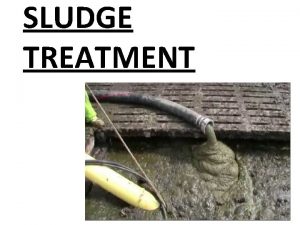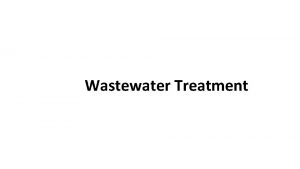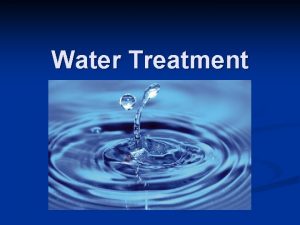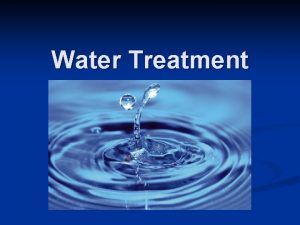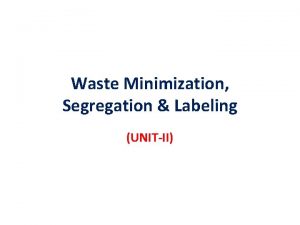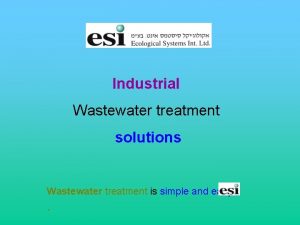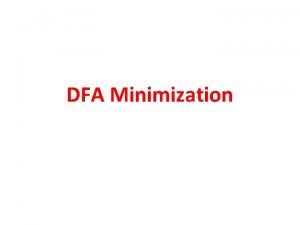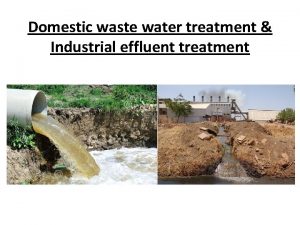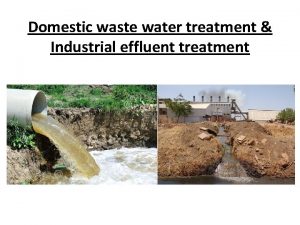Industrial Water wastewater Treatment Waste Minimization Sludge Handling















- Slides: 15

Industrial Water & wastewater Treatment Waste Minimization & Sludge Handling

Introduction - Residuals is a term currently used to refer to “sludge” - The higher the degree of wastewater treatment, the larger the quantity of sludge to be treated and handled - In order to reduce the operating costs (approximately 50% of the plant costs) of wastewater treatment plants, the need for reducing the volume of sludge has become increasingly important. - Properly designed and efficiently operated sludge processing and disposal system is essential to the overall success of the wastewater treatment effort.

Sewage Sludge Bio-solids - The end product of wastewater sludge treatment processes is refered as “biosolids”. - It is a recyclable primarily organic solid material produced by wastewtaer treatment processes. - It is also a solid organic matter recovered from sewage treatment process and used especially as fertilizer for plants. - Its more reuse potential rather than the term “treated wastewater sludge”

Use and Disposal of Sewage Sludge Bio-solids used in many ways include: - Land application to agricultural land. - Land application to nonagricultural lands ( parks, highways, recreational areas, golf courses) Disposal methods of bio-solids include: - Disposal in municipal landfills - Disposal on delicate sites , surface disposal and incineration. Surface disposal includes piles of bio-solids left on the land surface and land application to dedicated nonagricultural land, and disposal in monofills. Monofills: a landfill intended for one type of waste only

Regulatory requirements Pathogen reduction requirements for land application of bio-solids are divided into two categories: Class A and Class B bio-solids. The six treatment alternatives for bio-solids include: - Alternative 1, thermally treated. - Alternative 2, high PH-high temperature treatment - Alternative 3, other processes treatment - Alternative 4, unknown processes - Alternative 5, use of the processes for further reduce pathogens (PFRP) and - Alternative 6, use of a process equivalent to PFRP


Regulatory requirements EXAMPLE 1 What is the required minimum time to achieve Class A pathogen requirement when a bio-solid with 15% solids content is heated at 60 o. C ?

Regulatory requirements EXAMPLE 2 Determine the required minimum temperature to treat bio-solid containing 15% solids with a heating time of 30 min.

Regulatory requirements Bio-solids Class B requirements ensure that pathogens have been reduced to levels that are unlikely to pose a threat to public health and environment under specific conditions of use. Class B bio-solids must meet one of the following alternatives: 1 - Monitoring of indicator organisms density. 2 - Bio-solids are treated in one of the processes to significantly reduce pathogens (PSRP). 3 - Use of the processes equivalent to PSRP.

Regulatory requirements Land application Bio-soilds applied to land either to condition the soil or to fertilize crops in the soil - Bio-soilds can apply to land in bulk or sold or in bags. - The application sites may be nonpublic contact sites 9 agricultural lands, forests, reclamation sites). Public contact sites (public parks, roadsides, lawns and home gardens). - All land application of bio-solids must meet the ceiling concentration limits for 10 heavy metals listed in the second column of below table. - Bio-solids applied to the land must meet pollutant concentration (PC limits , commutative pollutant loading rate (CPLR) limits


Regulatory requirements Annual Whole Sludge Application Rate AWSAR for bio-solids sold or given a way in a bag can be determined by dividing the annual pollutant loading rate by pollutant concentration.

Example 3 Ten heavy metals listed in previous table were analyzed in bio-solids to be sold. The chromium concentration is 20 mg/Kg of bio-solids. Determine the AWSAR of chromium for the bio-solids. .

Regulatory requirements Calculation of Annual Bio-solids Application rate on Agricultural Land Sewage sludge has been applied to agricultural land for long time. - The use of bio-solids in agricultural land can replace costly commercial fertilizers. - The annual application rates of biosolids should not exceed the nutrients (N and P) requirments of the crop grown on an agricultural soil. - calculations will be make are depends on : - 1 - Nitrogen - 2 - Phosphorus - 3 - pollutant limitation

Next Lecture Sludge treatment alternatives
 Ap environmental science chapter 11
Ap environmental science chapter 11 Sludge treatment
Sludge treatment Wastewater treatment purpose
Wastewater treatment purpose Characteristics of aquaculture
Characteristics of aquaculture Wastewater treatment process primary secondary tertiary
Wastewater treatment process primary secondary tertiary Ashbridges bay wastewater treatment plant
Ashbridges bay wastewater treatment plant Municipal wastewater treatment
Municipal wastewater treatment Agricultural wastewater treatment technologies
Agricultural wastewater treatment technologies Anaerobic wastewater treatment
Anaerobic wastewater treatment Sacramento regional wastewater treatment plant
Sacramento regional wastewater treatment plant Agricultural wastewater treatment technologies
Agricultural wastewater treatment technologies Rectangular clarifier design
Rectangular clarifier design Secondary wastewater treatment
Secondary wastewater treatment Nampa wastewater treatment plant
Nampa wastewater treatment plant Wastewater treatment for dairy industry
Wastewater treatment for dairy industry Secondary wastewater treatment
Secondary wastewater treatment
